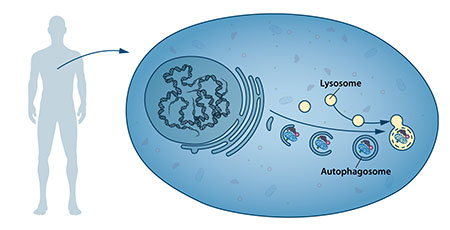Despite the bizarre claims of supernaturalists like Joe Mercola, D.O., or writers on Livestrong, the controlled digestion of damaged organelles within a cell are complex. Autophagy kills the cells
under certain conditions and is involved in programmed cell death - apoptosis. Autophagy is from the Greek auto ("self") and phagein ("to eat") and Ohsumi used baker's yeast to identify genes essential for autophagy, which opened the path to understanding the fundamental importance of autophagy in many physiological processes, such as in the adaptation to starvation or response to infection, and even perhaps disease and cancer.
Christian de Duve won the Nobel Prize in Physiology or Medicine in 1974 for the discovery of the lysosome, which is the organelle containing enzymes that digest proteins, carbohydrates and lipids.

Our cells have different specialized compartments. Lysosomes constitute one such compartment and contain enzymes for digestion of cellular contents. A new type of vesicle called autophagosome was observed within the cell. As the autophagosome forms, it engulfs cellular contents, such as damaged proteins and organelles. Finally, it fuses with the lysosome, where the contents are degraded into smaller constituents. This process provides the cell with nutrients and building blocks for renewal. Credit: Nobel Assembly at Karolinska Institutet
The types of autophagy are:
microautophagy – in this process the cytosolic components are directly taken up by the lysosome itself through the lysosomal membrane.
macroautophagy – this involves delivery of cytoplasmic cargo to the lysosome through the intermediary of a double membrane-bound vesicle. This is called an autophagosome that fuses with the lysosome to form an autolysosome.
Chaperone-mediated autophagy – in this process the targeted proteins are translocated across the lysosomal membrane in a complex with chaperone proteins (such as Hsc-70).
micro- and macropexophagy
piecemeal microautophagy of the nucleus
cytoplasm-to-vacuole targeting (Cvt) pathway
Citation: Takeshige, K., Baba, M., Tsuboi, S., Noda, T. and Ohsumi, Y. (1992). Autophagy in yeast demonstrated with proteinase-deficient mutants and conditions for its induction. Journal of Cell Biology 119, 301-311




Comments